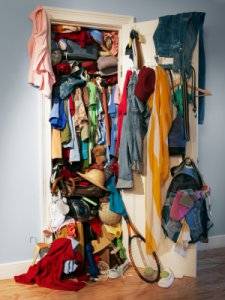 Since I am sure that you’ll be busy cleaning your closets in the Spring(!), I thought that the beginning of Fall would be a good time for you to get rid of your Lightroom clutter. Here are some essential Lightroom clean-up tasks:
Since I am sure that you’ll be busy cleaning your closets in the Spring(!), I thought that the beginning of Fall would be a good time for you to get rid of your Lightroom clutter. Here are some essential Lightroom clean-up tasks:
1. Delete most of your Lightroom catalog backups.
If you back up your catalog as often as I do mine, this will save you many gigabytes of hard drive space. Next time you do a backup, in the backup prompt dialog box note where the backups are being stored. Outside of Lightroom, using Windows Explorer or Finder, go to this folder and delete most of the date folders. I like to keep a few spread out in time — a day ago, a week ago, a month ago, three months ago. The rest can go. If you are not backing up your catalog and your images, read this post on backing up everything. Here also is a post that lists other ways to reclaim hard drive space from Lightroom.
A word of caution first: some users accidentally end up using one of their backup catalogs as their main catalog — make sure you haven’t done this before you delete the backups: go to Edit (Lightroom on a Mac)>Catalog Settings. This shows you where your main catalog is. If it is in a date folder, be sure not to delete this one!
2. Resolve all those question marks you have on photos and folders.
Here is a blog post on why you have question marks and how to resolve them. To find all photos with question marks, you can go to Library>Find Missing Photos. If you then want to go to the folder one lives in, right-click in the photo and choose Go to Folder in Library. (Note that in Lightroom 5, folders still have question marks on them, but photos have small exclamation marks “!”.)
3. Delete collections that you no longer need.
Right-click on the collection name and choose Delete. This will not delete the photos from your hard drive or remove them from Lightroom — trust me!
4. Delete develop presets you don’t use.
All those free presets sounded great, but if you’re not using ones you downloaded or ones you have created, right-click and Delete. You can also use the method I explain in #8 to delete many at once. (Deleting Lightroom’s default presets is much more complicated — you have to get into the source code, and they will still come back next time you do an update.)
5. Delete print, slideshow and web templates.
Right-click and Delete.
6. Delete unused keywords (I’ll have more on cleaning up duplicate keywords in a future post).
Right-click and Delete individual ones in the Keyword List panel, or go to Metadata>Purge Unused Keywords to remove all keywords that haven’t been associated with any images. (Thanks, Mike P., for this second way.)
7. Delete file renaming custom presets.
In the drop down in the file naming section of the Import dialog, choose Edit… Then choose your preset from the top drop down. Finally, from the same top drop down, choose Delete Preset…
8. Delete watermarks and other presets.
For watermarks, and other presets you can’t figure out how to delete otherwise, go to Edit (Lightroom on a Mac)>Preferences, click on the Preset tab, and click on the Show button. This will open a Windows Explorer or Finder window, with either your preset folder or your catalog folder highlighted. Open it, open your Lightroom Settings folder, and go into any of the preset/template folders and delete as needed. You will have to restart Lightroom to see the changes take effect. If you accidentally delete Lightroom’s official presets, back in the Preferences dialog click on the Restore Presets buttons.
9. Delete all those photos that you know you don’t want or need.
This of course is the most obvious clean-up task, but the hardest for some of us to do. Nevertheless, it will certainly save you the most hard drive space. When you delete, choose Delete from Disk, and not Remove. (Remove takes them out of Lightroom, but leaves them on your hard drive.)
[sc:signup]Related Content:
More Fall Cleaning: Eliminating Lightroom Keyword Duplicates and Misspellings
Help! My Photos Are Completely Unorganized and Lightroom is a Mess! How Can I Just Start All Over?
